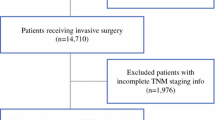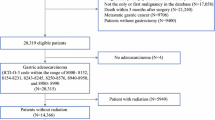Abstract
Objectives
TNM stage is the preeminent cancer staging system and a fundamental determinant of disease prognosis. Our goal was to evaluate the predictive power of TNM stage for gastric adenocarcinoma (GAC), in a low-incidence country.
Methods
A province-wide chart review of GAC patients diagnosed from April 1, 2005 to March 31, 2008 was conducted in Ontario and linked to routinely collected vital status data with a follow-up on March 31, 2012. TNM staging was classified using the sixth and seventh Union International for Cancer Control/American Joint Committee on Cancer editions. Kaplan-Meier and log-rank tests compared stage-stratified survival estimates. Discrimination was evaluated using Harrell’s C statistic.
Results
The cohort included 2366 patients. One- and 5-year survival was 43% and 17%. Using the sixth edition, 9% of patients had stage I disease, 5.4% stage II, 7.3% stage III, and 64% stage IV; 15% were not staged. Using the seventh edition, 9% were stage I, 7.7% stage II, 16% stage III, and 54% stage IV; 14% were not staged. Stage-stratified 5-year survival ranged from 68% to 7% with the sixth edition and from 70% to 4% with the seventh edition. Harrell’s C statistic was 0.64 (0.63–0.65) for the broad sixth edition staging categories and 0.68 (0.67–0.69) for the broad seventh edition. Discriminative power was similar for the refined stage categories and across multiple subgroup analyses; it was best in non-metastatic patients.
Conclusion
Existing staging systems for GAC used in North America predict individualized prognosis poorly. The creation of a more complex prediction tool is necessary to provide accurate and precise prognostication information to oncologists, patients, and their families.
Résumé
Objectifs
La classification TNM est le principal système de stadification du cancer, en plus d’être un déterminant fondamental du pronostic de la maladie. Nous avons cherché à évaluer la capacité prédictive de la stadification TNM pour l’adénocarcinome gastrique (ACG) dans un pays à faible incidence.
Méthode
Un examen des dossiers médicaux des patients ayant reçu un diagnostic d’ACG entre le 1er avril 2005 et le 31 mars 2008 a été mené à l’échelle de l’Ontario et maillé aux données sur le statut vital systématiquement recueillies, avec suivi jusqu’au 31 mars 2012. Le stade TNM a été déterminé selon les 6e et 7e éditions de la classification de l’UICC/AJCC. Les estimations de survie stratifiées selon le stade ont été comparées à l’aide des tests de Kaplan-Meier et du log-rank. La discrimination a été évaluée à l’aide de l’indice C de Harrell.
Résultats
La cohorte était constituée de 2 366 patients. Le taux de survie après un et cinq ans était de 43 % et de 17 %, respectivement. Selon la 6e édition, 9 % des patients avaient un cancer de stade I, 5,4 % de stade II, 7,3 % de stade III et 64 % de stade IV; pour 15 %, le stade était indéterminé. Selon la 7e édition, 9 % des patients avaient un ACG de stade I, 7,7 % de stade II, 16 % de stade III et 54 % de stade IV; pour 14 %, le stade était indéterminé. La survie après cinq ans stratifiée selon le stade variait entre 68 % et 7 % selon la 6e édition et entre 70 % et 4 % selon la 7e édition. L’indice C de Harrell était de 0,64 (0,63-0,65) pour les catégories de stadification générales de la 6e édition et de 0,68 (0,67-0,69) pour les catégories générales de la 7e édition. La capacité de discrimination était semblable pour les catégories de stadification détaillées et selon de nombreuses analyses par sous-groupes; elle était la plus efficace pour les patients ayant un ACG non métastatique.
Conclusions
Le système de stadification existant de l’ACG utilisé en Amérique du Nord est inefficace pour offrir un pronostic individuel. Il est nécessaire de créer un outil de prédiction plus complexe pour fournir des pronostics exacts et précis aux oncologues, aux patients et aux familles.




Similar content being viewed by others
References
American Joint Committee on Cancer. (2002). AJCC cancer staging manual—6th Edition. Chicago: Springer-Verlag New York, Inc.
American Joint Committee on Cancer. (2012). AJCC staging manual (7th edtion ed.). Chicago: Spring.
American Joint Committee on Cancer (2017) AJCC cancer staging manual, 8th Edition, Springer International Publishing.
Ashfaq, A., Kidwell, J. T., McGhan, L. J., et al. (2015). Validation of a gastric cancer nomogram using a cancer registry. Journal of Surgical Oncology, 112, 377–380.
Bringeland, E. A., Wasmuth, H. H., Mjones, P., et al. (2017). A population-based study on incidence rates, Lauren distribution, stage distribution, treatment, and long-term outcomes for gastric adenocarcinoma in Central Norway 2001–2011. Acta Oncologica, 56, 39–45.
Canadian Cancer Society (2017) Canadian Cancer Statistics 2017.
Coburn, N. G., Lourenco, L. G., Rossi, S. E., et al. (2010). Management of gastric cancer in Ontario. Journal of Surgical Oncology, 102, 54–63.
Collins, G. S., Reitsma, J. B., Altman, D. G., et al. (2015). Transparent reporting of a multivariable prediction model for individual prognosis or diagnosis (TRIPOD): the TRIPOD statement. BMJ, 350, g7594.
Dikken, J. L., Coit, D. G., Baser, R. E., et al. (2014). Performance of a nomogram predicting disease-specific survival after an R0 resection for gastric cancer in patients receiving postoperative chemoradiation therapy. International Journal of Radiation Oncology, Biology, Physics, 88, 624–629.
Dixon, M., Mahar, A. L., Helyer, L. K., et al. (2016). Prognostic factors in metastatic gastric cancer: results of a population-based, retrospective cohort study in Ontario. Gastric Cancer, 19, 150–159.
Han, D. S., Suh, Y. S., Kong, S. H., et al. (2012). Nomogram predicting long-term survival after d2 gastrectomy for gastric cancer. Journal of Clinical Oncology, 30, 3834–3840.
Howlader N, Noone AM, Krapcho M., et al. (2017). SEER Cancer Statistics Review, 1975-2014, based on November 2016 SEER data submission, Bethesda MD, National Cancer Institute.
Iron, K., Zagorski, B., Sykora, K., et al. (2008). Living and dying in Ontario: an opportunity for improved health information. Ontario: Institute for Clinical Evaluative Sciences.
ISD Scotland. (2016). Detect cancer early staging data. Scotland: ISD.
Kattan, M. W., Karpeh, M. S., Mazumdar, M., et al. (2003). Postoperative nomogram for disease-specific survival after an R0 resection for gastric carcinoma. Journal of Clinical Oncology, 21, 3647–3650.
Kattan, M. W., Hess, K. R., Amin, M. B., et al. (2016). American Joint Committee on Cancer acceptance criteria for inclusion of risk models for individualized prognosis in the practice of precision medicine. CA: a Cancer Journal for Clinicians, 66, 370–374.
Kwon, O. K., Kim, S. W., Chae, H. D., et al. (2016). Validation of the 7th AJCC/UICC staging system for gastric cancer and a proposal for a new TNM system based on a prognostic score: a retrospective multicenter study. Annals of Surgical Treatment and Research, 91, 295–302.
Lu, J., Huang, C. M., Zheng, C. H., et al. (2013). Consideration of tumor size improves the accuracy of TNM predictions in patients with gastric cancer after curative gastrectomy. Surgical Oncology, 22, 167–171.
Mahar, A. L., Coburn, N. G., Viola, R., et al. (2015). Predictors of hospital stay and home care services use: a population-based, retrospective cohort study in stage IV gastric cancer. Palliative Medicine, 29, 147–156.
Marrelli, D., Morgagni, P., de Manzoni, G., et al. (2012). Prognostic value of the 7th AJCC/UICC TNM classification of noncardia gastric cancer: analysis of a large series from specialized Western centers. Annals of Surgery, 255, 486–491.
McGhan, L. J., Pockaj, B. A., Gray, R. J., et al. (2012). Validation of the updated 7th edition AJCC TNM staging criteria for gastric adenocarcinoma. Journal of Gastrointestinal Surgery, 16, 53–61; discussion 61.
National Cancer Registration and Analysis Service. (2016). Stage breakdown by CCG 2014. London: NCRAS.
Northern Ireland Cancer Registry. (2016). Incidence by stage 2010–2014. Belfast: Queens University Belfast.
Novotny, A. R., Schuhmacher, C., Busch, R., et al. (2006). Predicting individual survival after gastric cancer resection: validation of a U.S.-derived nomogram at a single high-volume center in Europe. Annals of Surgery, 243, 74–81.
Patel, M. I., Rhoads, K. F., Ma, Y., et al. (2013). Seventh edition (2010) of the AJCC/UICC staging system for gastric adenocarcinoma: is there room for improvement? Annals of Surgical Oncology, 20, 1631–1638.
Pernot, S., Voron, T., Perkins, G., et al. (2015). Signet-ring cell carcinoma of the stomach: impact on prognosis and specific therapeutic challenge. World Journal of Gastroenterology, 21, 11428–11438.
Postlewait, L. M., Squires 3rd, M. H., Kooby, D. A., et al. (2015). The prognostic value of signet-ring cell histology in resected gastric adenocarcinoma. Annals of Surgical Oncology, 22(Suppl 3), S832–S839.
Rausei, S., Ruspi, L., Galli, F., et al. (2016). Seventh tumor-node-metastasis staging of gastric cancer: five-year follow-up. World Journal of Gastroenterology, 22, 7748–7753.
Reim, D., Loos, M., Vogl, F., et al. (2013). Prognostic implications of the seventh edition of the international union against cancer classification for patients with gastric cancer: the Western experience of patients treated in a single-center European institution. Journal of Clinical Oncology, 31, 263–271.
Sano, T., Coit, D. G., Kim, H. H., et al. (2017). Proposal of a new stage grouping of gastric cancer for TNM classification: International Gastric Cancer Association staging project. Gastric Cancer, 20, 217–225.
Shu, P., Qin, J., Shen, K., et al. (2017). The IGCA staging system is more accurate than AJCC7 system in stratifying survival of patients with gastric cancer in stage III. BMC Cancer, 17, 238.
Siegel, R. L., Miller, K. D., & Jemal, A. (2016). Cancer statistics, 2016. CA: A Cancer Journal for Clinicians, 66, 7–30.
Steyerberg, E. W. (2009). Clinical prediction models: a practical approach to development, validation, and updating. New York: Springer New York.
Zhang, J., Zhou, Y., Jiang, K., et al. (2014). Evaluation of the seventh AJCC TNM staging system for gastric cancer: a meta-analysis of cohort studies. Tumour Biology, 35, 8525–8532.
Author information
Authors and Affiliations
Corresponding author
Electronic supplementary material
Table S1
(DOCX 17 kb)
Rights and permissions
About this article
Cite this article
Mahar, A.L., Zagorski, B., Kagedan, D. et al. Evaluating TNM stage prognostic ability in a population-based cohort of gastric adenocarcinoma patients in a low-incidence country. Can J Public Health 109, 480–488 (2018). https://doi.org/10.17269/s41997-018-0102-1
Received:
Accepted:
Published:
Issue Date:
DOI: https://doi.org/10.17269/s41997-018-0102-1




